If you’ve been wondering about Ceramic Metal Halide or Light Emitting Ceramic grow lights, you’re on the right track. CMH grow lights are hands down the best HID grow lamp technology available on the market right now.
Also known as LEC grow lights, they have the best PAR spectrum of any HID lamp, the slowest degradation rate, and they’re also at least 10% more efficient than other HID lamps.
If you want to understand how ceramic metal halide grow lights work and how to use them, read on. By the end of this article, you will know everything you need to know!
If you’re just interested in the best CMH grow lights, here are the top choices:
Best CMH Systems
- Best Overall: Sun System LEC 315w CMH
- Best Value: Nanolux 315w CMH
Best CMH Bulbs
- Best Overall: Philips Mastercolor CDM-TP Elite 315w – 3100K | 4200K
- Best Value: Ushio HiLux Gro 315w CMH – 3100K | 4200K
Best CMH Ballasts
- Phantom II CMH 315w Digital Ballast
These products are reviewed in more depth below, but you can click on the links above to check out pricing or reviews.
What is a Ceramic Metal Halide Grow Light?
First of all, what are these lights actually called? Ceramic Metal Halide (CMH)? Light Emitting Ceramic (LEC)? Or are they Ceramic Discharge Metal Halide (CDM)?
The truth is that all those different names are talking about the same Ceramic Metal Halide (CMH) technology. LEC is actually a trademarked term for a CMH brand. In order to avoid confusion, I’m going to be using CMH in this article, which is the most common term.
Ceramic Metal Halide grow lights are basically a variation of MH grow lights with a little of HPS added into the mixture. A CMH uses a ceramic arc tube similar to those used in HPS grow lights instead of the quartz used in traditional metal halide grow lights.
The ceramic arc tubes operate at higher pressures than quartz glass tubes, which enables manufacturers to make more precise variations on the spectrum than with previous technologies.
The Advantages of CMH Grow Lights
There’s a reason people are looking into CMH grow lights, and it’s the huge list of advantages when compared to almost every other grow light option.
Balanced spectrum
Not only do you get a more balanced spectrum that hits almost every sweet spot for your plants but they’re also better at turning your electricity into usable light.
By comparison, HPS and MH lights waste a lot of energy producing light at ranges that are not efficiently used by plants. This means that CMH are more PAR efficient than either HPS or MH, making them a better single light solution.
Color Rendering Index
They also have a more natural CRI (Color Rendering Index). CRI describes how the color of a light source changes how an object appears to the human eyes and how well subtle variations in color shades are revealed. The higher the CRI, the more realistic things look. CMH grow lights are generally rated between 80 to 96 CRI, by comparison, the sun is rated at 100 CRI. This means that CMH grow lights will let you see the true color of your plants without making your grow room look yellow, blue or purple.
Ultraviolet Radiation
CMH grow lights provide UV (ultra violet) radiation, which although being outside of our range of vision is beneficial (at certain ranges and intensities) to plant growth and development. They produce UV-A, UV-B and UV-C Light, but UV-C is generally very harmful to human eyes. So most high quality manufacturers use a glass filter to block the UV-C output while leaving UV-A and UV-B output intact.
Note: All HID bulbs emit some amount of UV radiation. The amount may vary and they’re sometimes shielded. But remember not to look at or work around a bulb with a broken outer glass jacket because UV radiation burns, and this damage is cumulative.
Longer Lasting
Ceramic arc tubes are more resistant to breakdown, so they last a lot longer than MH and HPS bulbs. In fact, CMH grow lights tend to last over 24,000 hours while keeping at least 80% of their original intensity at the 20,000-hour mark. This overshadows the common 10,000-hour replacement rule for HPS & MH bulbs.
In summary:
- Balanced spectrum
- Better PAR efficiency than MH or HPS
- High CRI for visual appeal
- UV supplementation
- Lower heat output watt per watt
- Last longer than other HID grow lights
The Disadvantages of CMH Grow Lights
Weaker in Flowering Than HPS
When it comes to flowering crops, HPS lights are still the “HID King.” This is because HPS grow lights output more light in the red spectrum than CMH lights. Even still, the debate rages on. If you compare CMH to HPS on a watt by watt basis, CMH lights do have a more balanced PAR spectrum than HPS lights. And research is still being done to figure out if the added benefit of a better spectrum improves the overall crop even with the diminished harvest.
Heat Output
CMH grow lights usually output a lot of light in the infrared part of the spectrum (over 700 nm) which makes them output quite a lot of heat. Although it still less heat than other 400w HID bulbs, it’s noticeable even if they’re consuming a lower wattage.
Upfront Cost
Another disadvantage is the initial cost. Usually a high quality 400w MH or HPS grow light kit (including ballast, bulb and reflector) costs around $200, by comparison, the initial investment for a complete 315w CMH kit hovers around $500, which is a pretty hefty initial investment. However, in the long run CMH will still save you more energy.
In summary:
- Not the absolute best for flowering crops
- High heat output
- High initial investment
The CMH Grow Light Spectrum
When it comes to general growing, CMH offer the most complete PAR spectrum in any HID bulb available in the market. There may be other more “focused” grow lights, but if we’re going for the most overall balanced single grow light HID solution CMH sits at the top…and very comfortably too.
Here’s a comparison between the 3100K and the 4000K CMH spectrums, as well as HPS spectrum:
3100K Spectral Reading
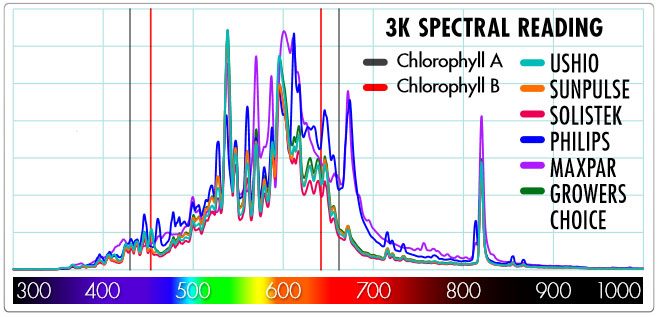 Spectral Reading of 3100k CMH Bulbs
Spectral Reading of 3100k CMH Bulbs4200K Spectral Reading
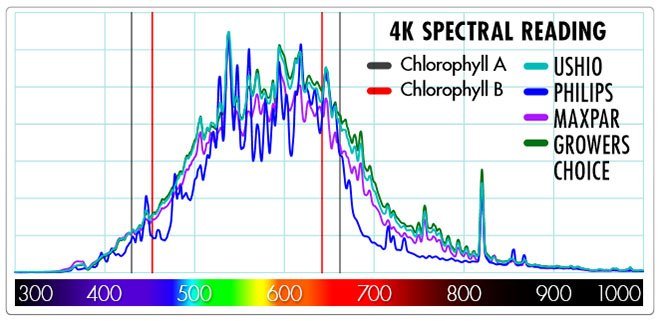 Spectral Reading of 4200K CMH Bulbs
Spectral Reading of 4200K CMH BulbsSpectral Reading of the EYE Hortilux Super HPS
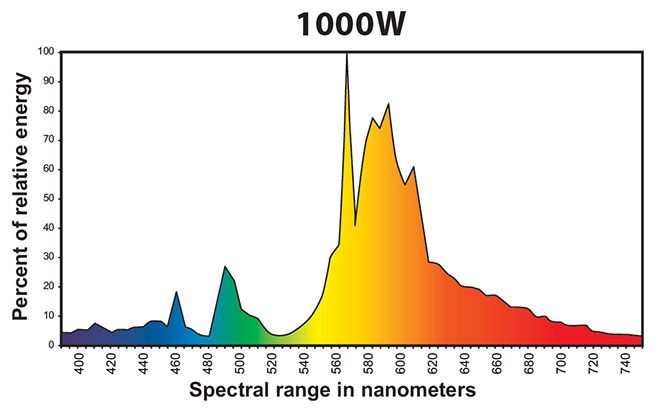 Spectral Reading of Eye Hortilux Super HPS
Spectral Reading of Eye Hortilux Super HPSJust so you know, the EYE Hortilux Super HPS is my pick for the best HPS bulb. So you can see the difference in output here.
If you remember that PAR is light in the range between 400 to 700 nanometers, and is the actual usable light by plants. You will notice that neither MH lamps, nor HPS lamps offer a more complete PAR spectrum in a single grow light. Generally, MH bulbs tend to be heavy on the blue, and HPS on the red side, which is why many growers who want the perfect canopy combine both technologies.
CMH may still be combined with HPS for an added boost on the red spectrum which benefits flowering crops so much.
Choosing a Ballast for a Ceramic Metal Halide Light
The specifics of CMH ballasts are a little bit tricky. It is highly recommended that you purchase a whole CMH kit instead of trying to retrofit a CMH bulb into your old ballast.
Usually CMH do not run on most electronic ballasts due to the extremely high frequency these ballasts output. Regardless, there are some high end electronic ballasts that can run CMH grow lights without any problems due to their microprocessors.
To avoid any problems and confusion, CMH manufacturers insist that you buy a CMH grow light kit, this comes with the bulb, the ballasts and a reflector all attached together for ease of use and installation.
A benefit of the square-wave technology ballasts required to run them, is that you won’t have to deal with the electromagnetic interference (EMI) issues many growers experience with digital ballasts.
Hanging & Positioning a CMH Grow Light
This is the PAR map of a Sun System LEC 315 grow light. It uses a Phillips 315W/930 (3100K spectrum).
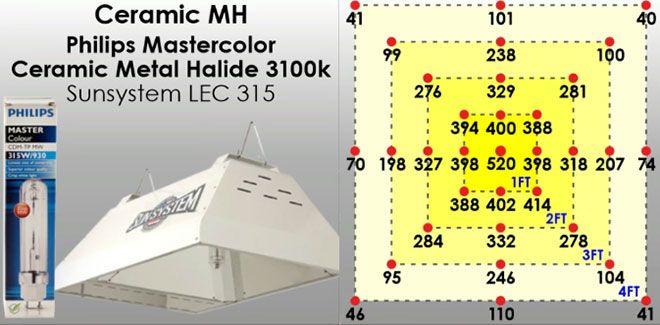
These PAR measurements were done at a height of two feet over the canopy which is the sweet spot for a 3 by 3 feet grow area. We don’t really recommend them for a 4 by 4 because the outer edges aren’t going to be receiving much light, but in the end that’s the growers call.
Ceramic Metal Halide lamps are usually rated for universal positioning, this means that they can be positioned vertically as well as horizontally, so feel free to play around with the positioning to find the best configuration for your grow area.
Summary:
- At least 2 feet over the canopy to avoid hot spots and provide a good spread
- 315w recommended for a 3×3 feet grow area up to a 4×4
- Can be placed in any position without damaging the bulb
CMH vs. MH
First of all, Ceramic Metal Halide and Metal Halide bulbs are not the same thing.
Even if they share a lot of the same technology they have fundamental differences in the way they’re constructed and how they operate. You can’t just use your new CMH bulb in your old MH ballast. Trying to do so would be very dangerous.
For comparison purposes, the only disadvantage I can think of CMH over MH is the initial cost. With that said we’ve made it clear that CMH has a much better overall spectrum than MH, especially with that red boost at both 3100k and 4000k spectrums. CMH also run cooler, and produce a lot more PAR light when compared watt per watt.
The most noticeable point is degradation time. Standard MH bulbs have a lifetime of around 10,000 Hours. Which is less than 50% of the 24,000 Hours that CMH are rated for.
MH Points
CMH Points
- Efficiency
- Significantly improved spectrum with a well needed boost in the reds over MH
- Prevents Stretching
- Significantly longer life time
CMH vs. HPS
As previously mentioned, HPS grow lights are still the king of flowering crops. And that’s pretty much the only thing they have over CMH.
HPS grow lights provide most of their PAR light as red light, which is exactly what flowering and fruiting crops need at that growth phase. But CMH grow lights still provide a more balanced PAR spectrum that doesn’t encourage stretching like the RED light from the HPS does, more PAR light per watt and an overall cooler operation.
My recommendation for anyone running Flowering crops is to use CMH as base lighting and use HPS as an added red light supplement to encourage the biggest and highest quality yields. Another point is that standard HPS need to be replaced every 9,000 Hours because of their significant degradation over time.
HPS Points
- Best flowering spectrum available
- More affordable
CMH Points
- Efficiency
- Balanced Spectrum for the complete cycle
- Prevents Stretching
- Over twice the usable life time
CMH vs. LED
In this case it all depends on what we’re comparing against. Horticultural LED lights have certain advantages over HID lights in that they’re more energy efficient, produce very low heat and can be placed very close to the canopy without burning the plants.
But as of right now LEDs are usually not recommended because they “underperform” due to manufacturers mislabeling their products with ridiculous claims. Even though, there are many upcoming LED grow light manufacturers who provide factual descriptions of their products.
For instance, there’s the SPYDR by FLUENCE which outputs a more evenly distributed and targeted PAR spectrum than a CMH while also covering a 4 by 4 feet canopy with a similar energy consumption. The downside is that this LED setup is very expensive. It costs around $900, and at that price point a CMH setup is definitely a more affordable alternative unless low heat conditions and closeness to the canopy are an absolute necessity.
The CMH vs. LED battle is still going on, there are LED technologies like SMDs and COBs which seem very promising for indoor and outdoor growers looking for cooler and more efficient lighting. Only time will tell who comes on top.
LED Points:
- Can easily target specific PAR ranges
- Much lower heat production
- Much longer operating time
- Not many options (still in development)
CMH Points:
- Much more affordable
- Lower usable life time
What Should You Buy?
As a general rule, it’s best to buy a complete CMH system due to the issues you may face in trying to retrofit a CMH bulb to an old ballast of yours. If you’ve already decided you want to grow with ceramic metal halide technology, then you’ve gotten over the fact that they’re a bit more expensive than standard HID options.
Below, I’ve chosen the best systems, bulbs, and ballasts on the market for CMH growers, so no matter which route you take, I’ve got you covered.
Best CMH Grow Light Systems
Best Overall: Sun System LEC 315w CMH
As I’ve recommended, it’s often best to just get a CMH system instead of piecing it together yourself, mostly due to compatibility issues with ballasts.
The Sun System LEC comes with your choice of 3100K or 4200K bulbs, and 120v or 240v. It includes a compatible square wave electronic ballast, so you won’t have any funky issues trying to match the bulb up to an old ballast.
All in all, you’ve got a hooded reflector, ballast, and bulb for a price that’s hard to beat. This is by far the top choice for a complete CMH system.
See Prices
Best Value: Nanolux 315w CMH Fixture
The Nanolux is another good option if you’re looking to save a little bit of cash. The ballast is top mounted, so everything hangs above your plants. This could be a bit scary, so make sure you have a good grow tent that’s capable of holding up all that weight.
Unfortunately, the Nanolux does NOT come with a bulb, which contributes to its lower price. However, if you have your eye set on a specific CMH bulb, then the additional customization may be a benefit to you.
All in all, this is a great choice if you want to save about $100 (after purchase of a bulb).
See Prices
Best CMH Grow Light Bulbs
Best Overall: Philips Mastercolor CDM-TP Elite 315w

Philips was one of the first companies to develop and manufacture ceramic metal halide bulbs, so it’s no surprise that their bulbs are the best in class. This isn’t just personal opinion — it’s objectively the best.
What I mean by this is that the Philips bulb, whether in 3100K or 4200K, has the highest PAR measurements of any CMH bulb currently on the market. They do about 8% better than the second best bulb.
The Philips Mastercolor is available in 3100K and 4200K.
Best Value: Ushio HiLux Gro 315w CMH
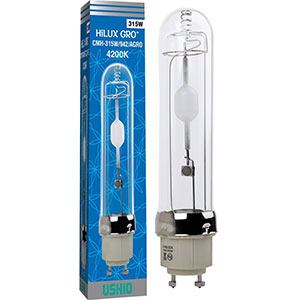
If you’re looking for another option besides the Philips, the Ushio HiLux Gro is a solid choice. Ushio is well-known for their quality bulbs and earned most of my “best value” picks in my best HPS bulb roundup.
The Ushio HiLux Gro is available in 3100K and 4200K.
Best CMH Ballasts
Phantom II CMH Digital Ballast
If you absolutely want to build your own CMH system instead of buying a bundle, the Phantom II CMH digital ballast is a great option. I would still stress that you buy a bundle instead, because the price of this ballast plus the other gear you need to get your CMH system up and running will likely cost more than just buying a system outright.
However, you may already have a bulb and reflector and just need a ballast. For those of you in this situation, the Phantom II is a square-wave ballast from Hydrofarm that is your best option.
See Prices
Conclusion
We’ve extensively explored CMH technology and arrived at the conclusion that there is no better single HID grow light solution available in the market.
Not only do they save you energy and produce less heat per watt used and provide very good light spread, but they’re also a complete-cycle growing solution suitable for most green and flowering crops with their balanced spectrum output, UV supplementation and the capability to be hanged in any position over the canopy.
The only downside right now is their high price, which hopefully will decrease as they flood the market and become a more accessible option for growers looking to step up their grow.
- http://growershouse.com/blog/cmh-315w-lamp-comparison-test-data-review/, Grower’s House
- https://www.youtube.com/watch?v=ELjXp4iR2HI, YouTube









